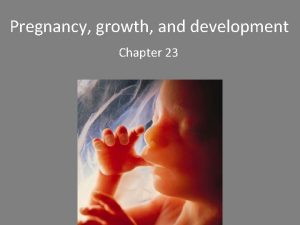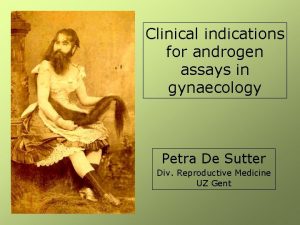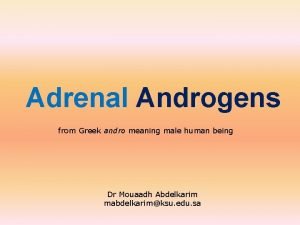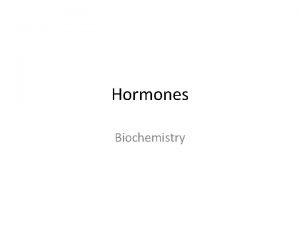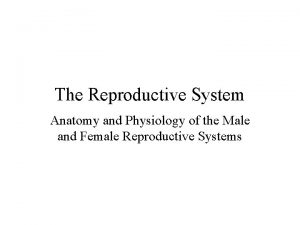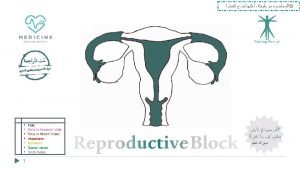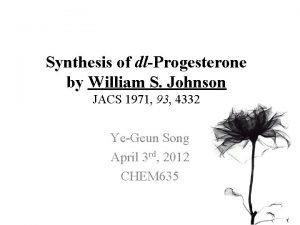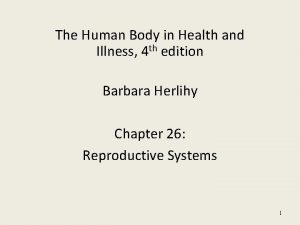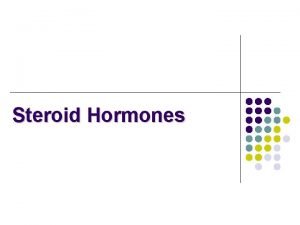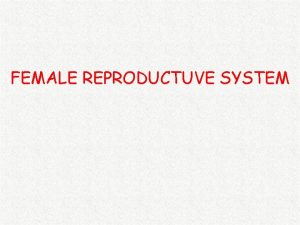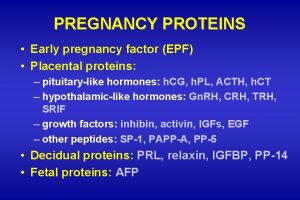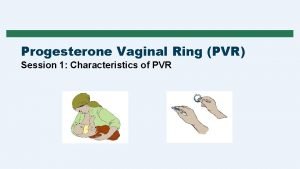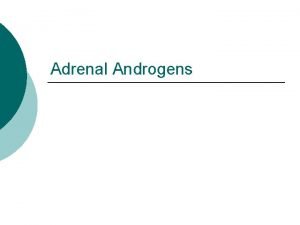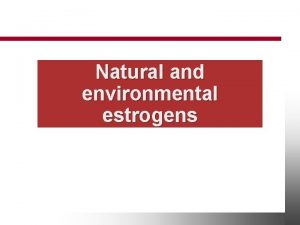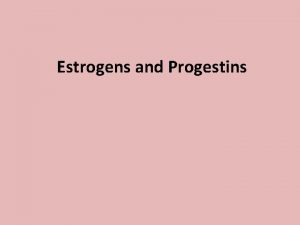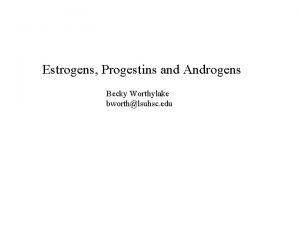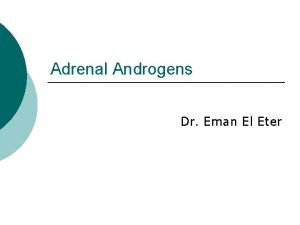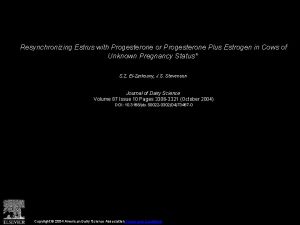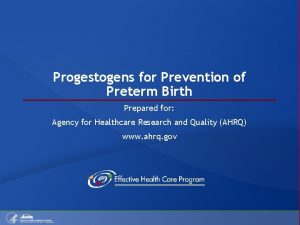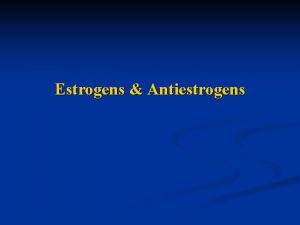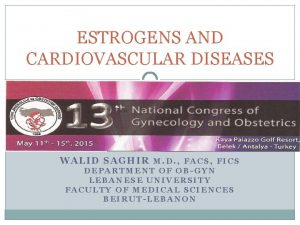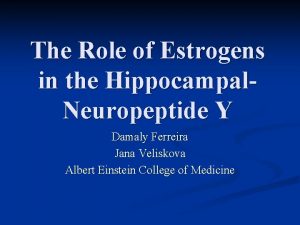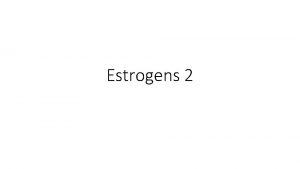Estrogens androgens PROGESTOGENS Progesterone the natural progestogen is















- Slides: 15

Estrogens & androgens

PROGESTOGENS Ø Progesterone (the natural progestogen) is produced in response to (LH) by both females (secreted by the corpus luteum, primarily during the second half of the menstrual cycle, and by the placenta) and by males (secreted by the testes). Ø It is also synthesized by the adrenal cortex in both sexes.

Ø If conception takes place, progesterone continues to be secreted, maintaining the endometrium in a favorable state for the continuation of the pregnancy and reducing uterine contractions Ø Mechanism of action involves intracellular receptor/altered gene expression, as for other steroid hormones. Ø Oestrogen stimulates synthesis of progesterone receptors, whereas progesterone inhibits synthesis of oestrogen receptors.

Action 1) an increase in hepatic glycogen, probably through an insulin-mediated mechanism(Progesterone increases basal insulin levels and the insulin response to glucose). 2)a decrease in Na+ reabsorption in the kidney due to competition with aldosterone at the mineralocorticoid receptor cause hyperkalemia. 3) an increase in body temperature through an unknown mechanism; 4) a decrease in some plasma amino acids; and an increase in excretion of urinary nitrogen.

Therapeutic uses Ø The major clinical uses of progestogens are to treat a hormonal deficiency and for contraception Ø Progestins are also used for the control of dysfunctional uterine bleeding, treatment of dysmenorrhea (Norethisterone), and management of endometriosis and infertility Ø For successful implantation allylestrenol and dydrogesterone used in threated and habitual abortion also hydroxy progesterone

Adverse effects Ø headache, depression, weight gain, and changes in libido Ø Injectable medroxyprogesterone acetate has been associated with an increased risk of osteoporosis Ø Drospirenone may raise serum potassium due to antimineralocorticoid effects, and concurrent use with other drugs (for example, ACEI) may increase the hyperkalemia.

Antiprogestin Ø Mifepristone is a progesterone antagonist with partial agonist activity Ø The major adverse effects are abdominal pain, significant uterine bleeding and the possibility of an incomplete abortion. Ø Mifepristone has also been investigated as an oral contraceptive and an emergency contraceptive agent.

Danazol Ø Gonadotropin inhibitor—Danazol suppresses the pituitaryovarian axis, of gonadotrophins (FSH and LH). and consequently reduces oestrogen synthesis in the ovary. Ø In men, it reduces androgen synthesis and spermatogenesis. Ø Danazol has been reported occasionally to suppress adrenal function.

CONTRACEPTIVES Major classes of contraceptives: 1) Ø Monophasic combination pills contain a constant dose of estrogen and progestin given over 21 days. Ø With either type of combination oral contraceptive, active pills are taken for 21 days followed by 7 days of placebo.

Mechanisms of action 1. estrogen provides a negative feedback on the release of LH and FSH by the pituitary gland, thus preventing ovulation. 2. Progestogen negative feedback decreases the pulse frequency of gonadotropin-releasing hormone (Gn. RH) release by the hypothalamus Progestogen inhibit (LH) surge

2) Transdermal patch Ø contraceptive patch containing ethinylestradiol and the progestin norelgestromin. Ø One contraceptive patch is applied each week for 3 weeks to the abdomen, or buttock. Week 4 is patch free, and withdrawal bleeding occurs. 3) Vaginal ring: Ø An additional contraceptive option is a vaginal ring containing ethinyl estradiol and etonogestrel. Ø The ring is inserted into the vagina and is left in place for 3 weeks. Week 4 is ring free, and withdrawal bleeding occurs.

4) Progestin-only pills Ø Progestin-only pills deliver a low, continuous dosage of drug. These preparations are less effective than the combination pill and they may produce irregular menstrual cycles more frequently than the combination product. 5 -Injectable progestin 6 -Progestin implants: Ø A subdermal implant containing etonogestrel offers longterm contraception. Ø 4 -cm capsule is placed subdermally in the upper arm and provides contraception for approximately 3 years. Ø Principal side effects of the implants are irregular menstrual bleeding and headaches.

7 -Progestin intrauterine device: A levonorgestrel-releasing intrauterine system offers a highly effective method of longterm contraception. The nonhormonal copper intrauterine device provides contraception for up to 10 years.


Adverse effects • Breast fullness, depression, fluid retention, headache, nausea, and vomiting. • Carcinogenicity, • Abnormal glucose tolerance • Estrogen causes an increase in HDL and a decrease in LDL (a desirable occurrence), whereas progestins may negate some of the beneficial effects of estrogen.
 Secretes estrogens and progesterone
Secretes estrogens and progesterone Excess of androgens
Excess of androgens Androgens meaning
Androgens meaning Glucocorticoids mineralocorticoids and androgens
Glucocorticoids mineralocorticoids and androgens Corpus luteum
Corpus luteum Corpus luteum secretes
Corpus luteum secretes Primary amenorrhea
Primary amenorrhea Phases of uterine cycle
Phases of uterine cycle Johnson synthesis of progesterone
Johnson synthesis of progesterone Birth canal is formed
Birth canal is formed Steroids classification
Steroids classification Progesterone function
Progesterone function Difference between estrogen and progesterone
Difference between estrogen and progesterone Short luteal phase progesterone
Short luteal phase progesterone What is progesterone
What is progesterone Use of progesterone
Use of progesterone
